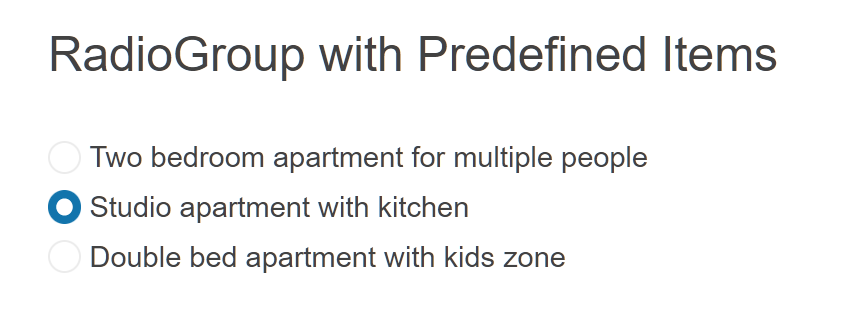Getting Started with the RadioGroup
This tutorial explains how to set up a basic Telerik UI for ASP.NET MVC RadioGroup component and highlights the major steps in the configuration of the component.
You will initialize a RadioGroup component with a set of items. Then, you will use the events of the UI component.

Prerequisites
To successfully complete the tutorial, you need a project that is already configured to use the Telerik UI for ASP.NET MVC components:
To create a new pre-configured project for the Telerik UI for ASP.NET MVC components, you can use a project template.
To manually configure an existing project by using NuGet, see the Adding Telerik UI through NuGet.
1. Prepare the CSHTML File
The first step is to add the required directives at the top of the .cshtml document:
-
To use the Telerik UI for ASP.NET MVC HtmlHelpers:
@using Kendo.Mvc.UI
Optionally, you can structure the document by adding the desired HTML elements like headings, divs, paragraphs, and others.
@using Kendo.Mvc.UI
<h4>RadioGroup with Predefined Items</h4>
<br/>
<div>
</div>
2. Initialize the RadioGroup
Use the RadioGroup HtmlHelper to add the component to a page:
- The
Name()configuration method is mandatory as its value is used for theidand thenameattributes of the RadioGroup element. - The
Items()collection contains the list of Items representing the available options. - The
Value()configuration applies the initial selection to a given item.
@using Kendo.Mvc.UI
<h4>RadioGroup with Predefined Items</h4>
<br/>
<div>
@(Html.Kendo().RadioGroup()
.Name("radiogroup")
.Items(i =>
{
i.Add().Label("Two bedroom apartment for multiple people").Value("1");
i.Add().Label("Studio apartment with kitchen").Value("2");
i.Add().Label("Double bed apartment with kids zone").Value("3");
})
.Value("2")
)
</div>
3. Handle a RadioGroup Event
The RadioGroup component provides convenient events for implementing your desired logic. In this tutorial, you will use the exposed Change() event to log a new entry in the browser's console.
@using Kendo.Mvc.UI
<script>
function onChange(e) {
console.log("Change :: old value: " + e.oldValue + ", new value: " + e.newValue);
}
</script>
<h4>RadioGroup with Predefined Items</h4>
<br/>
<div>
@(Html.Kendo().RadioGroup()
.Name("radiogroup")
.Items(i =>
{
i.Add().Label("Two bedroom apartment for multiple people").Value("1");
i.Add().Label("Studio apartment with kitchen").Value("2");
i.Add().Label("Double bed apartment with kids zone").Value("3");
})
.Value("2")
.Events(e => e.Change("onChange"))
)
</div>
4. (Optional) Reference Existing RadioGroup Instances
You can reference the RadioGroup instances that you have created and build on top of their existing configuration:
-
Use the
idattribute of the component instance to establish a reference.<script> var radiogroupReference = $("#radiogroup").data("kendoRadioGroup"); // radiogroupReference is a reference to the existing RadioGroup instance of the helper. </script> -
Use the RadioGroup client-side API to control the behavior of the widget. In this example, you will use the
enablemethod to disable the RadioGroup.<script> var radiogroupReference = $("#radiogroup").data("kendoRadioGroup"); // radiogroupReference is a reference to the existing RadioGroup instance of the helper. radiogroupReference.enable(false); </script>